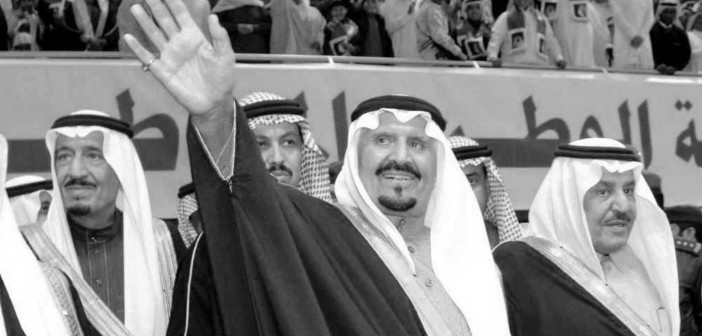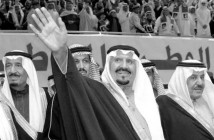What’s in a name? Covering over 80% of the Arabian Peninsula, founded and ruled by the Al Saud dynasty, the Kingdom of Saudi Arabia is a most vaguely named nation, failing to describe its inhabitants asha’ab as-sa’udi, the “Saudi people.”
Even Saudis themselves do not understand the idea of who is “Saudi” and what it means to be…
This lack of definition leads not only to internal socio-political debates, but leaves room for manipulation from not only those outside the societal mainstream, such as by fundamentalist groups, but also by those outside the Kingdom.
Modern Saudi Arabia is the result of the third attempt of the Al Saud dynasty to establish an Islamic monarchy over the Arabian Peninsula. Declared on the 23rd of September 1932, its origins date back to the Pact of Diriyyah between a local emir, Mohammed bin Saud, and the religious reformer Mohammed bin Abdulwahab (eponym of “Wahhabism”) in 1744.[1] Thus was born “the First Saudi State.” After temporarily annexing the Hejaz with the holy places of Makkah and Madinah, it was crushed by an Egyptian-led Ottoman army in 1818. It was succeeded by a much smaller Second Saudi State centered on Najd in central Arabia, which eventually collapsed due to infighting between the Al Saud in 1891. The modern Third Saudi State is the result of a nearly 30-year process by Abdulaziz “Ibn Saud” during what is known as the “unification of the kingdom.” Despite this long history – the nation and its citizens today suffer from a lack of a national identity.
Diverse Populations
The creation of Saudi Arabia was truly the unification of four historic regions: the Hejaz in the west, Najd in the center, Al Hasa in the east, and ‘Asir in the southwest. Moreover, each region itself contained heterogeneous populations: tribes dominated Najd and ‘Asir, and maintained an important presence in non-urban regions of the Hejaz and Al Hasa. The Hejaz contained three historic mercantile urban centres in Jeddah, Makkah and Madinah, while settled populations were also found in Qassim in Najd and Al Hasa in the East. Within the tribal segments of Arabian society, the distinction between the settled segments of the tribes – the “Hadar” – and the nomadic ones – the “Badu,” or Bedouins – was also significant.
Bonds that Unite
In light of the collapse and mismanagement of the Ottomans and Hashemites in Arabia following the First World War, the resurgent Al Saud proposed an all-encompassing Islamic identity based on Abdulwahab’s interpretation of the religion. Through over 20 unions and around 40 sons, Abdulaziz was able to gain the allegiance of the tribes of Arabia. Lack of a tribal society and severe differences in Islamic interpretations, however proved more difficult to reconcile, and other forms of creating adhesion would prove necessary in bonding the regions outside of Najd to the State.
Co-opting the Merchants of the Hejaz
In the Hejaz, the withdrawal of the Ottomans was followed by a brief and unpopular Hashemite monarchy, which particularly alienated the merchant elite of Jeddah, Makkah and Madinah. In 1925, being Sultan of Najd, Abdulaziz conquered the Hejaz. In Najd the allegiance of tribal sheikhs easily guaranteed the loyalty of tribes, whilst urban societies in the Hejaz lacked cohesive all-inclusive leaders.
The merchant elite would fill this void. For them, the Al Saud secured monopolies and an expanded market throughout the peninsula. The Ottoman-era mayor of Jeddah, Hajj Abdullah Alireza, was asked to stay on as governor in a gesture of continuance and goodwill Alireza and the merchants of the Hejaz lent Abdulaziz money necessary to maintain his government in the pre-oil era. Hejazi merchant families arose from the Al Saud rule with prestige.[2] Co-option of elites, along with allegiance, became the bond of the Hejaz to the monarchy.[3]
Coercing the East
Unlike the Hejaz, the bonds tying the Shiites of the east to the State were forced. The discovery of oil flooded the region with Sunni immigrants from both Najd and the Hejaz in the mid-20th century. The East would face another massive Sunni immigration, by Southerners, in the 1990’s after the start of Saudisation. The suppression of Shia rituals until 1993 by an agreement between Shia exiles and then-King Fahad[4] left an unpleasant idea of being Saudi in the minds of native Saudi Shia of the Eastern Province. The bonds of the Shia to the State are the newest and contemporarily the weakest. Shia critics have historically claimed that the monarchy disrupted the historic interdependence of the Hejaz, Najd and Al Hasa reducing the country to reliance on Najd.[5] The subjugation of Shia populations to more discriminatory measures is believed to have been a modern response to failed uprisings of Saudi Shia following the Iranian Revolution of 1979 and the politicisation of Shiites worldwide.[6]
The 2003 National Dialogue, when Sunni and Shia clerics met and discussed religion with one another for the first time marked a turning point in the relation of Shia citizens to the State. Two issues have strained the nascent relationship of the Saudi State to its Shia citizens, however: the Saudi-Iranian détente; and the Saudi-led Gulf Cooperation Council intervention against the majority-Shia unrest in Bahrain in the spring of 2011.
The weak bonds of Shiite citizens to the State not only cause concern for national unity, it also highlights the deficiency of national identity in general in the Kingdom. Despite a tumultuous past, Saudi Shia are proud of their historic presence in the Arabian Peninsula. Over the past two decades, Shia intellectuals in the Kingdom have embraced civil society discourse, and speak of a kingdom of all its citizens.[7] The alienation of Shiite citizens poses a threat to the continuity, stability, and unity of the Kingdom’s citizens: this national identity deficiency is a severe vulnerability of the people, which allows “divide and conquer” tactics more playing room by both domestic and external actors.
“Najdification”
Today in Saudi Arabia, the definition of what is meant by the term al asl as-sa’udi, or “Saudi origins” is highly debated. There would seem to be no doubt as to whether any Najdi of tribal origins is “really” Saudi. Conversely, Hejazis, Shiites and other regions of the kingdom have less solid socially accepted claims to being “original” Saudis. During his infamous blasphemy case in 2012, Jeddah-native Hamzah Kashgari was denounced as being “not originally Saudi,” because of his family’s Turkmen ancestry[8], not only by many Saudis on Twitter[9], but even by prominent Najdi clerics. The “Saudi” demonym has somehow evolved to be the exclusive domain of Najdis who solely can claim to be “originally” Saudi, hence, the “Najdification” of mainstream society.
Being Saudi
In entrenching itself, the State portrays the nation as a mega-tribe, with the citizens as members of the tribe and with the monarchy as its sheikh. The lack of a national identity in Saudi Arabia stands in contrast to the patriotism of their neighbors in Bahrain, Egypt, Kuwait, and the United Arab Emirates. However, nascent civil society associations, charities, and community-service projects popping up in the Kingdom’s main centres could prove to be the basis for the emergence of a grassroots national identity. Until then, however, the mainstream acceptance of “Najdi” as the standard for what is “Saudi” continues to be a fact of life in Saudi Arabia. Hejazis, Shiites of the East, the northern tribes and Southerners as well were likewise founding constituencies of the modern Saudi state – their culture, lexicon, and most importantly, people, are and should rightly be viewed as really, originally Saudis.
[1]Habib, J. S. (2009). Wahhabi Origins of the Contemporary Saudi State. In M. Ayoob& H. Kosebalaban (Eds.), Religion and Politics in Saudi Arabia: Wahhabism and the State (pp. 57-73). Boulder, Colorado & London: Lynne Rienner Publishers.
[2]Consulate-General of the United States in Jeddah (1992-08-28).Jeddah’s Merchant Elite: The Alirezas. WikiLeaks. WikiLeaks cable: 91JEDDAH1892. Retrieved 2012-09-12.
[3]Consulate-General of the United States in Jeddah (1992-08-28).Jeddah’s Merchant Elite: The Alirezas. WikiLeaks. WikiLeaks cable: 91JEDDAH1892. Retrieved 2012-09-12.
[4]Teitelbaum, J. (2010). The Shiites of Saudi Arabia.Current Trends in Islamist Ideology, (10).
[5]Al-Rasheed, M. (2002).A History of Saudi Arabia (pp. 199-200). Cambridge, England: Cambridge University Press.
[6]Teitelbaum, J. (2010). The Shiites of Saudi Arabia.Current Trends in Islamist Ideology, (10).
[7]Al-Hasan, H. (1993).Al-Shi’ah fi al mamlakah al-’arabiyah as-sa’udiyah (p. xxx). Beirut, Lebanon: Mu’assasat al-Baqi‘ li-Ihya’ al-Turath.
[8] Having long been the point of access to the Two Holy Mosques, the population of the Hejaz and Jeddah in particularly are ethnically diverse and a microcosm of Muslim lands both past and present.
[9]Abbas, F. J. (2012, February 14). Once you tweet, you can’t retreat. Gulf News. Retrieved from: http://www.gulfnews.com





1 Comment
yes a good essay…i often get called being a pakistani or indian all because my name has akbar in it…..and its difficult to tell them that my parents and great grandparents going back 1000 yrs are from the arabian peninsula…..never mind the national id crisis in light of there being more from the begali tribe than all the ghamdis and zahranis …..as well as pashtuns from pakistam ….all in all our so called tribes are small minorities in their own land….the dissipation of ethnicities is taking hold the world over…..the greatest threat comes from the avallanch of foreign labor …..a result of confused labor policies and not well thought out long term objectives…..but what is even more striking as we lose our national identity is the lack of public participation in policy making…..the al saud is begging for its irrelevence…..